We normally associate the guillotine with the French Revolution and the period known as “The Terror.” There are different estimates of the total number of victims claimed by “The National Razor” during the French Revolution with anywhere from four thousand up to ten-fold or, forty thousand lives lost to Dr. Joseph Guillotin’s machine. Well, it is likely that Hitler and the Nazis executed more than sixteen thousand using twenty fallbeil or, guillotines scattered around Germany in various prisons. The victims were primarily German citizens—young and old—men, women, and children—some whose only crimes were distributing anti-Nazi leaflets.
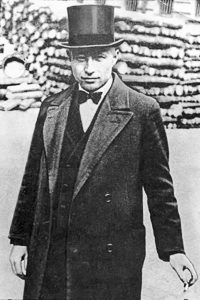
Did You Know?
“What if?” What if Abraham Lincoln was never assassinated? Would Jim Crow laws ever have existed? What if Martin Luther King, Jr. had not been assassinated? Would he have been our first African-American president? What if Lenin hadn’t died in 1924 and was able to prevent Stalin from taking over? Could the Cold War (and the Great Purge with its murder of 1.2 million Russian citizens) have been prevented? “What if?” scenarios can be applied to just about any historical situation. In this case, it’s about the Nazis coming to power. The German Communist Party (KDP) was a legitimate political party often collaborating with the German socialist party known as the Social Democratic Party (SDP). The KDP was independent from Moscow’s influence but when Stalin was able to control the Communist International (an organization which enveloped the world’s Communist parties), he ordered all local Communist parties to be subordinate to the Communist International and Moscow. Once that was accomplished, Stalin ordered all Communist parties to regard socialist parties as their enemy and to end any collaboration. By 1928, the KDP and the SDP accounted for more than forty percent of the German parliamentary vote. They often formed a working coalition. The National Socialist German Workers Party or, commonly known as the Nazi Party, controlled less than three percent in the late 1920s. After Stalin’s directive, the two parties (KDP and SDP) could not vote together and one of the results was the increase in representation of the Nazi party culminating five years later with Hitler coming to power. So, what if Stalin had not issued his resolution stating that socialism was “more dangerous than the avowed adherents of predatory imperialism.” Would the KDP and SDP working together have been able to thwart Hitler’s plans and prevent the twelve years of the thousand year Third Reich?
Hitler Comes To Power
The stage was set. After losing World War I and forced to make what even some of the victors considered to be unreasonable reparation payments, Germany suffered through hyperinflation. The Weimar Republic was weak and by the time the consequences of the American stock market crash in October 1929 reached Germany, millions were out of work and banks collapsed. Taking advantage of the lack of cohesive leadership and the general suffering of the voters, the National Socialist German Worker’s Party or, the Nazi Party began to espouse a far right-wing nationalistic position. The Nazis’ platform included a national and cultural renewal. Hitler promised a strong central government, a better economy with jobs, increased Lebensraum (“living space”), a rejection of the terms of the Versailles Treaty, and the collapse of the unpopular Weimar Republic. They also made no attempt to hide their plans for the treatment of Jews and people of “inferior” races (i.e., anyone other than those of the Germanic or Aryan race). In other words, the Nazis were about to serve up a policy of racial cleansing. Hitler was named as Chancellor of Germany on 30 January 1933. Almost immediately, he began to enforce the Nazi brand of brutality and suppression of rights. The first order of business was to implement Gleichschaltung or the idea of making everything conform (at least to the Nazi party’s ideas). By June 1933, the Nazis had replaced the leadership in all civilian organizations with members of the Nazi party—only the army and the churches were not under Nazi control. One month after he came to power, Hitler ordered a boycott of all Jewish businesses. The SS (Hitler’s bodyguards) and the SA (the Brownshirts) began to harass Communists, Social Democrats, and Jews. Beatings of individuals were common place on the streets of Berlin and other German cities. On 27 February 1933, the Reichstag burned down and a Dutch communist was found guilty of setting the fire. Hitler used this to push through a decree abolishing German civil liberties, including the right to assemble and freedom of the press. German citizens for the most part supported all of this. One of the things that Hitler would not tolerate was any action detrimental to the Nazi party. This included protesting, defeatism, or criticism and would be treated as acts of treason. If a German refused to obey the party’s instructions regarding the treatment of Jews, it would be considered a crime. If a German resisted Nazi propaganda or the Nazis’ policies, it would be considered a treasonable crime. The punishment for treason was death.
The First Concentration Camp
The first concentration camp was established in March 1933 near the small village of Dachau. It was the only camp which ran continuously from the beginning of the Nazi reign to its demise twelve years later. Dachau was originally set up to hold political prisoners and communists. The Nazis had not yet perfected their extermination camps (e.g., Auschwitz, Treblinka, and Sobibór) and developed the systematic killing machine that reached its zenith between 1942 and 1945. Sometimes the term “concentration camp” is used to describe every camp developed by the Nazis. For example, some authors mistake a detention center for a “concentration camp.” However, the Nazis designated their camps for certain prisoners and functions. One such extermination camp was Natzweiler-Struthof, the only extermination camp located in France. It was the final destination for victims of Hitler’s program called Nacht und Nebel (NN). (Click here to read Night and Fog and click here to read Women Agents of the SOE). Inmates held under NN were usually executed and all traces of their existence vanished. The Drancy Detention camp in Paris was used to house men, women, and children (usually Jews) after the roundups conducted by the French police. (Click here to read The Roundup and the Cycling Arena). Drancy was the holding center prior to their deportation to Auschwitz. Labor camps were also extermination camps but the methodology used to murder the inmates was different. Forced labor from the occupied countries was used to augment and support the Nazi economy and war production. Up to 15 million people were abducted or “volunteered” for the Nazi factories, camps, or other facilities. Many of these people would die (as the Nazis intended) from mistreatment, malnutrition, torture, and being over worked. Because so much historical attention has been placed on the concentration/extermination camps, labor camps, and detention centers, very little information is known or written about the various Nazi prisons used to punish German citizens who did not conform to the Nazi regime or its policies (refer to “Recommended Reading” at the end of this blog).
Nazis Prisons
By 1941, there were approximately ninety-five penal institutions, each with a capacity of 500 or more inmates, located in cities within the borders of Nazi Germany. Four cities maintained multiple prison sites (Berlin, Graz, Hamburg, and Leipzig). The prisons were used to house convicted criminals including murderers, street crime, prostitution, and other common crimes. They were also used as execution sites for Nazi protesters, foreign agents, and others who were convicted of high treason. Approximately half of the executed victims were German citizens while the remainder were resistance fighters from Poland, Czechoslovakia, and France. The German families of the executed were required to pay for their relative’s incarceration as well as the cost of the executions. Plötzensee Prison in Berlin became one of the most notorious prisons in the Nazi system where almost 3,000 people were executed after being convicted by the “People’s Court.” (Click here to read Hitler’s Blood Judge). By 1942, hangings were added to the Nazis’ execution process inside a ground-level brick building. The shed was divided into two areas separated by a curtain. A steel beam was installed in the back with eight meat hooks. In front of the curtain stood the guillotine. Plötzensee was one of the central sites for the executions of convicted 20 July Plot conspirators, including Carl-Heinrich von Stülpnagel (1886−1944), military governor of occupied France. Hitler ordered many of the almost 5,000 victims to be hanged by piano wire from the steel beam.
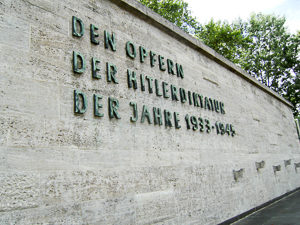
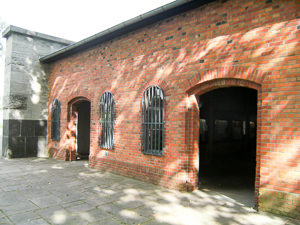
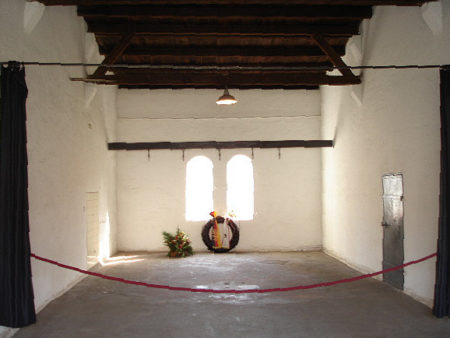
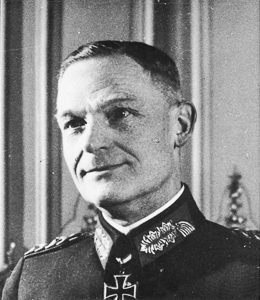
Originally, Hitler was against the use of the guillotine as he felt it would be associated too closely with the period of the French Revolution known as “The Terror.” He did not want to alarm German citizens so he had rogue Germans shipped off to concentration camps where they would never be heard from again (throughout the occupation of France, condemned women would be deported to Germany for execution as the Germans did not want it known they were murdering French women). However, by 1936, Hitler had been convinced to use the guillotine as the official instrument of execution in German prisons. Twenty guillotines were ordered and placed throughout Germany with the most notorious guillotine located at Plötzensee.
The Nazi Executioner
Johann Reichhart (1893−1972) was credited with more than 3,000 executions between 1924 and 1945 (250 of these were women). In addition to his duties at Plötzensee, Reichhart carried out Nazi executions in the other four central prisons located at Cologne, Frankfurt, Brandenburg, and Breslau. After the war, Reichhart was hired by the Allies and he supervised the construction of the gallows used to hang the Nuremberg trial convicted war criminals as well as instructing the American hangman, John Woods, in proper hanging procedures. Reichhart’s post-war life saw his wife divorce him, his son commit suicide in 1950, rejected by other Germans, and dying as an impoverished citizen living only on a World War I pension.
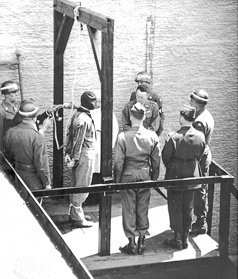
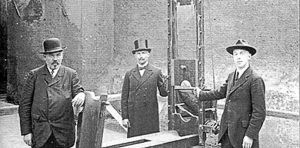
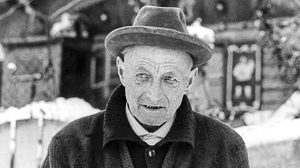
Discovery of the Nazi Guillotine
A grim discovery was made in early 2014. Deep inside the Bavarian National Museum in Munich and hidden in a non-descript storeroom was the original guillotine used by Reichhart at Plötzensee. It was used to behead members of the protest movements called the White Rose (click here to read the blog) and Rote Kapelle, (click here to read the blog) Otto and Elise Hampel (executed in 1943 for distributing postcards denouncing the Nazi regime—high treason), and other Nazi resistance opponents.
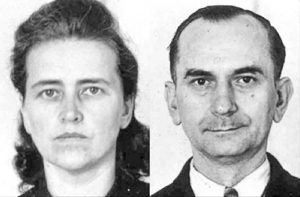
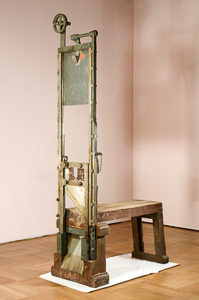
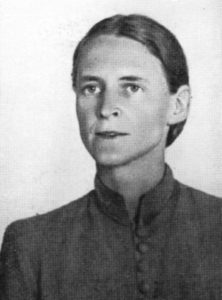
Recommended Reading and Viewing
If you would like to learn more about today’s subject, I suggest you read the following books or watch these movies or other documentaries: Wachsmann, Nikolaus. KL: A History of the Nazi Concentration Camps. New York: Farrar, Straus and Giroux, 2015. Wachsmann, Nikolaus. Hitler’s Prisons: Legal Terror in Nazi Germany. New Haven and London: Yale University Press, 2004. Each of Dr. Wachsmann’s books have to be one, if not the only, comprehensive and definitive study of the German labyrinth of camps and prisons.
What’s New With Sandy and Stew?
We just returned from several weeks of cruising around the British Isles. Sandy and I visited Guernsey (the only British soil occupied by the Germans during World War II), Ireland (our first visit here—loved Dublin but not so much Belfast), Scotland (visiting St. Andrew’s Golf Course was great), and of course, London. When I was growing up in Europe during the mid-1960s, there was an English city no one wanted to visit: Liverpool. Today, it is a beautiful city and we learned it had so much more to offer its visitors than just the Fab Four. For those of you who like visiting London and want to eat well (yes, English food has made a lot of progress over the decades), you might want to make a reservation at Scott’s Seafood. It is by far one of best seafood restaurants we’ve been to (be sure to order the octopus carpaccio). It is even better than Lucien’s in Amsterdam. Our next cruise is up the Amazon River where we will go fishing for piranha. We’ll let you know how piranha tastes.
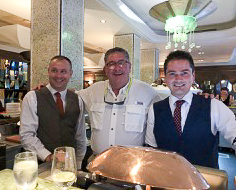
I will introduce you to some great private tour guides in our next blog (Church Sanctuary; 15 September 2018).
Someone Is Commenting On Our Blogs
Thank you to everyone who sends us an e-mail (either directly or through our web site) commenting on the blogs. We get a lot of questions, some we can answer and some we can’t. Keep ‘em coming. Sandy is investing a lot of time building our Pinterest site. Since she started, we’ve noticed an uptick in blog subscriptions and activity on the bi-weekly blogs. Check it out at: ![]() . For all of you social media wizards, let us know your thoughts on which social media platform we should be on in order to gain new friends.
. For all of you social media wizards, let us know your thoughts on which social media platform we should be on in order to gain new friends.
Why Would You Want To Buy Our “Walks Through History” Books?
Simple. You like to travel and experience history and historical events. You like to see original buildings that had a significant impact on the people and events of the history you’re engaged with. You want to know the stories behind the brick and mortar in front of you. The walking tour books are meticulously researched so you can go directly to those sites and learn about the building’s history as well as an introduction to some of the more interesting people associated with it.
Thank You
Sandy and I appreciate you visiting with us. We have some exciting things on the horizon and we’ll keep you updated as we go along.
Share This:
Follow Stew:
Find Stew’s books on Amazon and iBooks.
Please note that we do not and will not take compensation from individuals or companies mentioned or promoted in the blogs.  Walks Through History Copyright © 2018 Stew Ross
Walks Through History Copyright © 2018 Stew Ross


There are two errors in the pictures of this article.
(a) The photo showing the hanging of Martin Weiss says the executioner is Reichhart. This is incorrect. It is actually Albert Pierrepoint the British executioner at Landsberg prison.
There were two sets of gallows at Landsberg prison. Pierrpoint used one set, and John Wood (the US Army executioner) used the other. The crime(s) determined which executioner was used. This photo shows Pierrepoint.
(b) The photo of the fallbeil (guillotine) shown is NOT the Plotzensee fallbeil. It is ‘mostly’ the same sort of mechanism (Mannhardt design) as Plotzensee, but is actually the Munich fallbeil. There are several differences from the real Plotzensee fallbeil. That was damaged in an air raid, and removed by the Russians at the end of the war.
Hi Jeff; thanks for your comments. I definitely intend to follow up but have been very busy recently. Once the dust settles, I’ll dig into this. After I do, I’ll reach out to you. STEW
Sorry, Jeff, but Pierrepoint never hung any criminals at Landsberg, which was an American Army prison and execution site. Reichart was recruited by the American Army and carried out over a hundred executions of convicted nazi war criminals using one of the two gallows.
at Landsberg. John Woods, the American Hangman used the other gallows. Pierrepoint carried out many executions at Hamelin jail in Germany and in Austria.
reichart was used as a consultant to the us hangman,
wich is a scandal inits own right as, he should of been executed himself, he got away because he was seen as only following orders and it was his work, before the war ,
wich is strange because he joined the nazi party in the 1930s
Thank you Mr. Gormer for your comments. There were a lot of strange decisions made in the post-war years. Decisions that are hard to explain sitting here almost eighty-years later. STEW
James is correct. Pierrepond hanged at Hameln. Hangings at Landsberg were carried out by Johann Reichhart and Master Sgt. Woods.
The fallbeil displayed today at Brandenburg-Gordon memorial site quite likely is from Plotzensee. Missing/replaced parts and markings on it can to traced to photos and films documenting it which were taken by the Soviet shock army which seized the Prison.
The Plotzensee fallbeil was build by Jos. Mannhardt and originally was installed at Bruchsal Prison. When central execution prisons were estabilshed beginning in 1936 the Bruchsal Mannhardt was taken to Plotzensee which had no mechanized beheading device.
The Plotzensee Mannhardt was damaged in an air raid. Photos of it in its damaged condition can be easily found on the Internet. The Soviets then prepared to transport it as a war trophy to the “Great Patriotic Museum” which was well-along in Kiev. However the Soviets found another Mannhardt found in good condition in Breslau Prison and chose that one for their museum. by Today the Breslau Mannhardt, sans blade, is displayed at the Great Patriotic Museum. So the damaged Plotzensee fallbeil stayed in East Berlin, rusting away. Eventually it was traded to the Allied/German occupying forces in West Berlin for supplies needed by the Soviets.
The restoration was likely done by West Germans is terrible. However the West Germans were building a memorial for the victims executed by fallbeil at the Brandenburg Prison.
However Brandenburg’s original fallbeil, a Tegel type not a Mannhardt, was now exhibited at the Berlin History Museum. The Berlin Museum soon put it on permanent loan to a prominent prison museum in Ludwigsburg.
So the poorly restored Plotzensee Mannhardt finally found a home at Brandenburg… and it is not the “original”.
Carter, thank you so much for this information! You have clearly researched the subject quite well. I will definitely follow up on your information to further educate myself. Thanks for subscribing to our bi-weekly blog. We always appreciated this type of feedback and comments. STEW
Thanks Stew,
I am ready to answer questions or respond to comments about executions and laws during the 1800 – 1949 period in Germany. Subjects of course concern the condemned, the sentences, execution prisons, execution techniques, etc. Incorrect information on these subjects abounds. Just in the above blogs, I find many subjects such as how the Nazi State came to standardize execution by fallbeil (guillotine) for all of the Reich and the
fate of the large number of professional executioners and “gehilfen” (the team of assistants) who helped sharfrichters like Johann Reichhart pictured in this blog).
My goal is to correct and/or expand upon any subjects. Questions are welcome.
Hi Carter; thank you for agreeing to be a future guest blogger. I’m looking forward to working with you and above all, learning from you. STEW
I was doing a little research on Sophie and Hans Scholl of the White Rose movement. Members of the Hitler youth movement who became disolussioned. Executed by Reichart. It never ceases to amaze me what is still hidden.
Hi Jean; Thanks for reaching out to me. You are right about the stories that can pop up. It is depressing knowing that people can lose their lives over an innocuous task of distributing leaflets. I hope you enjoyed the blog and that you might consider subscribing for future bi-weekly blogs. STEW
This was really interesting and gives one the chills!!😮
Hi Dan; Thanks for contacting us. I’m glad you found it interesting and yes, it is chilling (as most of the Nazi agenda was). I’ve had quite a few readers write us about this blog. Stay in touch. STEW